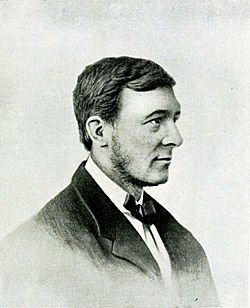Daniel Hanbury facts for kids
Quick facts for kids
Daniel Hanbury
|
|
|---|---|

Portrait of Daniel Hanbury, from Hortus Mortolensis, 1912
|
|
| Born | 11 September 1825 |
| Died | 24 March 1875 (aged 49) Clapham
|
| Resting place | Quaker burial ground, Wandsworth |
| Nationality | British |
| Alma mater | Pharmaceutical Society |
| Known for | Giardini Botanici Hanbury, La Mortola |
| Scientific career | |
| Fields | pharmacology, botany, pharmacognosy |
| Institutions | London, La Mortola |
| Author abbrev. (botany) | D.Hanb |
Daniel Hanbury (born September 11, 1825 – died March 24, 1875) was a British scientist. He was a botanist, meaning he studied plants, and a pharmacologist, someone who studies medicines. He was one of the first people to deeply study pharmacognosy. This is the study of how things from nature, especially plants, can be used as medicine.
Contents
Daniel Hanbury's Life
Daniel Hanbury was born on September 11, 1825, in a place called Clapham. At that time, Clapham was in Surrey, England. His father, Daniel Bell Hanbury, was a Quaker and also a pharmacist.
Early Education and Work
In 1833, Daniel went to Clapham Grammar School. When he was 16, in 1841, he started working at his father's company. The company was called Allen & Hanbury's and was located in the City of London.
He continued his training in pharmaceutical chemistry at the Pharmaceutical Society. While he was there, he met other pharmacists who were also interested in plants. These connections made him very interested in both botany (the study of plants) and pharmacognosy. He loved learning about where medicines came from, especially their plant and geographical origins.
Personal Life
Daniel Hanbury never got married. He was a vegetarian and, like many people in the Victorian era, he did not use alcohol or tobacco.
He stopped working in his business in 1870. In 1874, he worked with a Swiss botanist named Friedrich August Flückiger. Together, they published a very important book called Pharmacographia. Daniel Hanbury passed away on March 24, 1875, in Clapham. He was buried in the Quaker burial ground in Wandsworth.
Daniel Hanbury's Work
Daniel Hanbury knew a lot about plants from all over the world. He gained this knowledge from many years of studying, collecting, and traveling. He took trips to the Middle East and all across Europe. He also wrote many letters to other scientists around the globe.
Hanbury Botanical Gardens
Daniel was a key partner to his brother, Sir Thomas Hanbury. They worked together to choose plants and create the famous Giardini Botanici Hanbury. These beautiful botanical gardens are located in La Mortola, Italy. Today, the University of Genoa takes care of them.
After Daniel's death, Sir Thomas gave his brother's entire collection of plant specimens to Kew Gardens. This collection is now a part of their Economic Botany Collection.
Published Works and Recognition
Daniel Hanbury's first published article appeared in the Transactions of the Pharmaceutical Society. After that, he regularly wrote many articles and papers. These writings described how different plants, insects, and chemicals could be used as medicines. His work was published in important journals like the Pharmaceutical Journal and the Transactions of the Linnean Society.
During his career, he held several important positions. He was the president of the British Pharmaceutical Conference. He also examined students in botany for the Royal Pharmaceutical Society. In 1867, he was chosen to be a Fellow of the Royal Society, which is a great honor for a scientist.
In 1858, a scientist named Berthold Carl Seemann named a group of South American plants after him. This plant genus, or type of plant, is called Hanburia. It belongs to the Cucurbitaceae family, which includes plants like cucumbers and melons.

